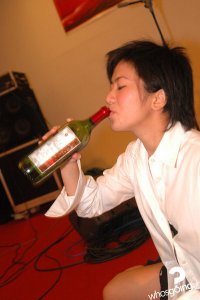Walgreen Co. plans to add beer and wine to its stores, marking a return to a business it exited more than a decade ago.
The Deerfield, Ill.-based drugstore chain expects to roll out the liquor category to stores nationwide in the next 12 to 18 months as part of a broader attempt to drive traffic and boost sales, Chief Executive Gregory Wasson said. The return to the liquor business comes as the nation's largest drugstore looks for ways to return to profit growth. The company is starting to reap the benefits of making over stores, cutting costs and expanding its healthcare businesses, Wasson said.
Walgreen's fiscal fourth-quarter net income fell 1.5%, beating Wall Street expectations.
"We've adjusted our retail model to respond to what we believe will be lasting changes in consumer behavior," Wasson said. The 108-year-old company is in the midst of what Wasson described as "one of the most important strategic and operational transformations in our company's history."
Wasson, who began his career at Walgreens drugstores as a pharmacist, was named CEO in January after leading the company's healthcare business. The retailer already had begun to shake up its insular culture before Wasson took the helm, hiring outsiders for top jobs in marketing, technology, finance and merchandising. The pace of change has accelerated under his watch.
Walgreens slowed the rapid-fire pace of building new stores this year and instead poured money into remodeling existing stores. The program, called "customer-centric retailing," is aimed at creating stores that are less cluttered, more tightly edited and easier to shop.
The drugstore chain opened 35 test stores this spring that have shown positive results, Wasson said, without providing specific details. The format is on its way to 400 stores in Texas and will arrive at stores nationwide next year. The new Walgreens also will have fewer impulse items, such as Chia Pets, and more consumer staples, such as toilet paper and toothpaste.
The store makeover was needed to compete with CVS Caremark Corp. and to battle the growing pharmacy businesses at Target Corp. and Wal-Mart Stores Inc., said Brendan Langan, director of retail insight at Management Ventures Inc., a Cambridge, Mass.-based research firm.
"The Walgreens of yesterday was designed for a shopper with more time than money," Langan said. "It was too hard to find things. They had too many products and too many promotions." As for the liquor business, it signifies a break from the past, Langan said.
"There are no sacred cows in Deerfield," he said. "Everything is up for evaluation." Walgreens had been selling liquor since the end of Prohibition, with an array of beer, wine and spirits. The retailer got out of the business in the early 1990s, citing the complexity and cost of operating the department. There also was some question as to whether it fit with the company's health-and-wellness image.
The new liquor departments will be scaled back, selling only beer and wine. Walgreens disclosed in June that it was applying for the local government licenses needed to reintroduce beer and wine to its national chain of more than 7,000 stores. Rival CVS said it sells liquor in about 4,100 of its 7,000 stores and has been doing so for at least the past 20 years.
By Sandra M. Jones
skip to main |
skip to sidebar
Enhance the pleasure that you get from wine by sharing your experiences, knowledge, news articles and facts about the elixir of the gods and bacchanalia on earth by emailing: bacchusforyou@bellsouth.net
How Much Did The Best Bottle of Wine You Ever Drank Cost?
CONTACT INFORMATION
TO SUBMIT A POST, TO BE PUT ON THE MAILING LIST, TO HAVE QUESTIONS ANSWERED, ETC.
EMAIL:



